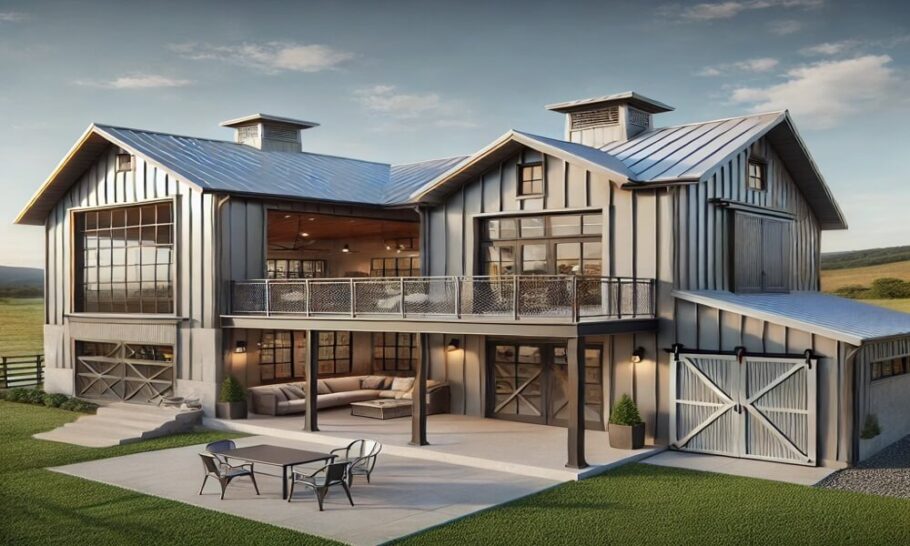Barndominiums have surged in popularity over the past decade, offering a unique blend of durability, affordability, and customizable living spaces. As more homeowners seek to make their barndominiums energy-efficient and environmentally friendly, interest in geothermal heating and cooling systems has grown. But is geothermal really a feasible solution for barndominiums?
In this blog post, we’ll explore how geothermal systems work, their pros and cons, and whether they’re a smart fit for your barndominium project.
What Is Geothermal Heating and Cooling?
Geothermal heating and cooling systems use the stable temperatures below the Earth’s surface to regulate indoor climate. While the air temperature above ground can vary wildly between seasons, temperatures just a few feet underground remain relatively constant—typically between 45°F and 75°F depending on geographic location.
How It Works
A geothermal heat pump system includes three main components:
- Ground Loop: Pipes buried underground circulate a fluid (usually water or an antifreeze solution) that absorbs or dissipates heat.
- Heat Pump Unit: Located inside the home, it transfers heat between the building and the ground loop.
- Distribution System: Usually ductwork or radiant floor heating that delivers warm or cool air to living spaces.
In winter, the system draws heat from the earth and transfers it indoors. In summer, it pulls heat from the indoor air and releases it underground. The system can also be used to heat water, reducing the need for a separate water heater.
Why Consider Geothermal for a Barndominium?
Barndominiums, often built from metal or steel framing, have different energy profiles compared to traditional homes. Metal conducts heat more readily, which can lead to energy inefficiency if not properly insulated. Here’s where geothermal can play a role.
Energy Efficiency
Geothermal systems can reduce energy usage by up to 50% compared to conventional HVAC systems. For a large barndominium—especially one with high ceilings or expansive open areas—this translates to significant long-term savings.
Environmentally Friendly
For those building barndominiums with sustainability in mind, geothermal systems offer one of the lowest carbon footprints among HVAC options. They produce zero on-site emissions and significantly reduce greenhouse gas emissions over their lifespan.
Low Operating Costs
After installation, operating costs are typically lower than those of propane, oil, or electric HVAC systems. With fewer mechanical parts exposed to weather, geothermal systems also require less maintenance.
Is It Feasible for Your Barndominium?
Now let’s get into the heart of the matter: is geothermal heating and cooling feasible for barndominiums? The answer depends on a few key factors.
- Installation Space
Geothermal systems require space to bury the ground loop. There are two common loop types:
- Horizontal loops, which require more land but are cheaper to install.
- Vertical loops, which are more expensive but suitable for smaller lots.
If your barndominium is being built on a rural property or open land—common for barndos—you likely have the space needed for a horizontal loop, making geothermal more feasible and cost-effective.
- Soil and Terrain Conditions
Soil composition, rockiness, and groundwater availability affect installation difficulty and cost. Sandy soils with good thermal conductivity are ideal. Rocky or shallow bedrock areas may require drilling (vertical loops), which can significantly increase costs.
Before proceeding, a site assessment by a geothermal installer is essential.
- Upfront Costs
Geothermal systems typically cost $15,000 to $35,000 installed—substantially higher than a conventional HVAC setup. However, several factors can offset the initial expense:
- Federal tax credits (currently 30% through 2032 in the U.S.)
- State and local incentives
- Energy savings that accumulate over time
- Increased property value
In many cases, the payback period is around 5 to 10 years, depending on your local climate and energy prices.
- Climate Considerations
Geothermal is especially effective in areas with wide seasonal temperature swings. Whether you’re in the hot South or the cold North, the consistent underground temperatures make geothermal efficient year-round.
In more temperate zones, the energy savings might be smaller, but the system still offers consistent comfort with less environmental impact.
Pros and Cons of Geothermal in Barndominiums
Pros
- High energy efficiency
- Consistent comfort year-round
- Lower operating costs
- Eco-friendly and sustainable
- Long system lifespan (25–50 years for ground loops)
Cons
- High initial cost
- Complex installation
- May require significant land area
- Not ideal for rocky terrain without vertical drilling
Integration Tips for Barndominium Builders
If you’re designing a barndominium and considering geothermal, here are some integration tips:
Plan Early
The best time to incorporate geothermal is during the planning and construction phase. This allows you to:
- Incorporate ductwork or radiant floor heating into the initial design
- Coordinate trenching for the loop system with other site work (e.g., plumbing, foundations)
- Avoid retrofitting costs
Insulate Properly
Even with geothermal, proper insulation is crucial. Barndominiums made of metal can lose or gain heat quickly. Use spray foam or high-performance insulation to reduce the load on your system and increase efficiency.
Pair With Solar Panels
Want to go even greener? Consider pairing geothermal with solar panels. The solar can help offset the electrical costs of the heat pump, moving you closer to net-zero energy usage.
Work With a Qualified Installer
Not all HVAC contractors are experienced in geothermal. Choose an installer certified by the IGSHPA (International Ground Source Heat Pump Association) or someone with a proven track record of geothermal installations in your area.
Final Verdict: Is It Worth It?
So, is geothermal heating and cooling feasible for barndominiums?
The short answer: Yes—but with caveats.
Geothermal is particularly feasible if:
- You’re building in a rural area with ample land
- You plan to stay in the home long-term
- You’re looking for long-term savings over upfront savings
- You prioritize energy efficiency and sustainability
However, if you’re on a tight construction budget or building in rocky terrain, it might not be the most practical choice—at least not without additional site work and cost considerations.
Conclusion
Geothermal heating and cooling is a highly efficient, eco-friendly solution for barndominiums—especially when planned from the beginning of the project. With proper design, site conditions, and budgeting, it’s not only feasible but a smart investment in the long-term comfort, sustainability, and value of your barndominium.
If you’re ready to build a barndominium that’s both tough and environmentally conscious, geothermal might just be the missing piece.

